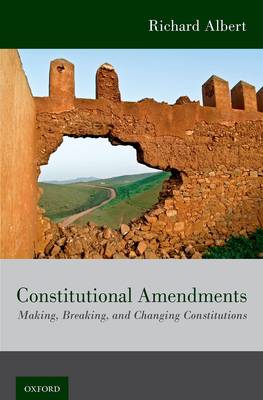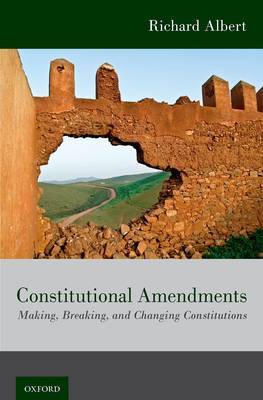
- Retrait gratuit dans votre magasin Club
- 7.000.000 titres dans notre catalogue
- Payer en toute sécurité
- Toujours un magasin près de chez vous
- Retrait gratuit dans votre magasin Club
- 7.000.0000 titres dans notre catalogue
- Payer en toute sécurité
- Toujours un magasin près de chez vous
Constitutional Amendments
Making, Breaking, and Changing Constitutions
Richard Albert
Livre relié | Anglais
209,45 €
+ 418 points
Description
Constitutional Amendments: Making, Breaking, and Changing Constitutions is both a roadmap for navigating the intellectual universe of constitutional amendments and a blueprint for building and improving the rules of constitutional change. Drawing from dozens of constitutions in every region of the world, this book blends theory with practice to answer two all-important questions: what is an amendment and how should constitutional designers structure the procedures of constitutional change? The first matters now more than ever. Reformers are exploiting the rules of constitutional amendment, testing the limits of legal constraint, undermining the norms of democratic government, and flouting the constitution as written to create entirely new constitutions that masquerade as ordinary amendments. The second question is central to the performance and endurance of constitutions. Constitutional designers today have virtually no resources to guide them in constructing the rules of
amendment, and scholars do not have a clear portrait of the significance of amendment rules in the project of constitutionalism. This book shows that no part of a constitution is more important than the procedures we use change it. Amendment rules open a window into the soul of a constitution, exposing its deepest vulnerabilities and revealing its greatest strengths. The codification of amendment rules often at the end of the text proves that last is not always least.
amendment, and scholars do not have a clear portrait of the significance of amendment rules in the project of constitutionalism. This book shows that no part of a constitution is more important than the procedures we use change it. Amendment rules open a window into the soul of a constitution, exposing its deepest vulnerabilities and revealing its greatest strengths. The codification of amendment rules often at the end of the text proves that last is not always least.
Spécifications
Parties prenantes
- Auteur(s) :
- Editeur:
Contenu
- Nombre de pages :
- 350
- Langue:
- Anglais
Caractéristiques
- EAN:
- 9780190640484
- Date de parution :
- 12-08-19
- Format:
- Livre relié
- Format numérique:
- Genaaid
- Dimensions :
- 163 mm x 236 mm
- Poids :
- 589 g

Les avis
Nous publions uniquement les avis qui respectent les conditions requises. Consultez nos conditions pour les avis.






